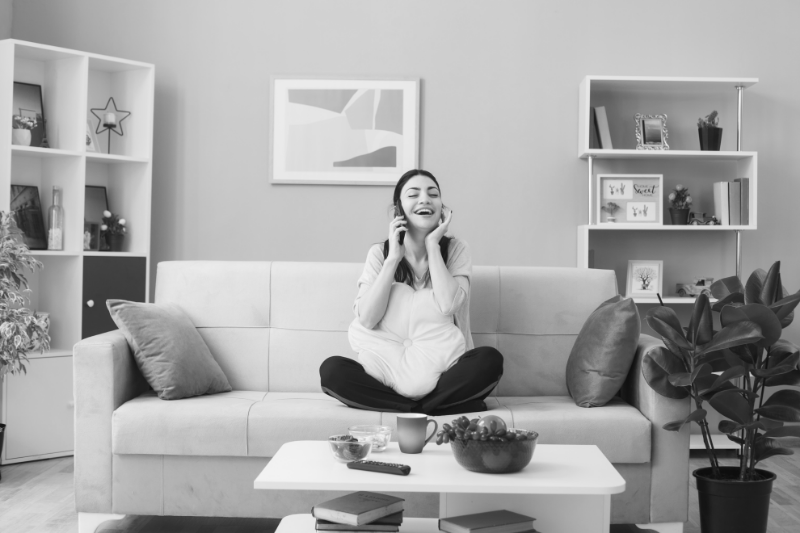Have you ever found yourself in a cluttered living space, creating chaos in your mind? Do you find yourself dodging the piles of possessions and struggling to move easily? Did you ever notice how this clutter impacts your health?
The hustle and bustle of your daily lives are often reflected in the cluttered state of your living spaces. In addition to being a nuisance to your environment, clutter has the power to adversely affect your health. It contributes to a variety of risks, from injuries and a sedentary lifestyle to stress and a lack of mental clarity.
The article explores the significant impact of adopting a minimalist mindset. Choose the right furniture and decor, and implement decluttering and organization hacks to improve your physical and mental health. Take a step toward minimalist transformation and redesign your living space for lasting positive change.
The minimalist mindset
Minimalism is a philosophy that emphasizes simplicity, elegance, and intentionality. It can be implemented in various domains of life, including lifestyle, design, art, and personal possessions. The philosophy emerged in New York in the 1960s, mostly through the efforts of a group of artists, including Carl Andre, Dan Flavin, Donald Judd, Sol LeWitt, Agnes Martin, and Robert Morris.
A minimalist mindset is a way to think and approach your life with intentional simplicity. The core feature is to let go of unnecessary possessions and distractions and embrace a simplified environment for a sense of peace.
People with a minimalist mindset seek to reduce clutter and follow a minimalist lifestyle at home. The effects of a minimalist mindset include more energy, time, space, and independence for things that bring joy, fulfillment, and meaning to life.
Benefits of minimalism
Amidst constant stimulation and distractions, adopting minimalism transforms your physical and mental health and offers a fulfilling existence. Here are some positive effects of minimalism in your living space.
Read more: Less is More: How Minimalism Transforms Home Organization
Mental clarity
What happens in your physical space (external world) often reflects your mental space (internal world). For instance, a cluttered home results in a chaotic mind.
However, minimalism creates a space in your external and internal world. Reducing or decluttering possessions in your physical space provides feelings of relief. Thus, minimalism helps you save mental energy and promotes well-being.
Improved mood
Your environment plays a crucial role in defining the status of your mental health as well. Residing in a cluttered environment can be overwhelming. In a minimalist home, your living space is designed to alleviate stress.
Minimalism promotes a positive emotional state by reducing stress and anxiety and uplifting mood. It relieves brain space and motivates you to pursue activities that foster healthy choices and fulfillment.
Enhanced focus
When you surround yourself with fewer items, you minimize the probability of being sidetracked by unnecessary possessions. The intentional removal of physical clutter supports an organized environment, enabling you to concentrate on your priorities. This minimalism directs your mental resources and energy toward the tasks that matter, heightening focus and productivity.
Enhanced mobility
Some people with health conditions may have mobility issues requiring mobility aids (e.g., wheelchairs, canes, etc) to move around the house independently and safely. In this case, implementing a minimalist approach (e.g., less furniture) maximizes space and provides ease of access.
Healthier food choices
The kitchen is one of the living spaces where clutter, in the form of unused or expired food items, is found. This contributes to decision fatigue and unhealthy food choices.
However, minimalism encourages you to regularly review and eliminate items that no longer have a function or support your health goals. Hence, minimalism can help promote intentional and mindful food choices.
Effective organization hacks for a minimalist living space
Modern minimalist interior design involves utilizing bare essentials to create an uncluttered and simple living space. It is characterized by clean lines, simplicity, functionality, and a monochromatic palette with colors. Such design combines functional furniture, many lights, and an open floor plan while focusing on the color, shape, and texture of essential elements.
Acknowledging the core principles of minimalist interior design allows you to take practical steps to transform your own minimalist living space. Here are some effective practical organization hacks to follow.
Implement decluttering techniques
A minimalist living space begins with implementing effective decluttering techniques. Decluttering allows you to remove unnecessary items from a particular place, making the space more serene and functional. Follow Marie Kondo’s method for decluttering and organization hacks to maintain a minimalist space.
- Ideal lifestyle. Explore and imagine the life you want to live (ideal lifestyle) to commit to the tidying process.
- Tidying up. Tidy up the entire space at once rather than doing it in small steps.
- Discard. Before you organize and purchase any storage essentials, discard items. Go through each item in your living space, which belongs to five categories (clothes, books, papers, miscellaneous, sentimental). Decide which items to keep and discard.
- Follow the order. When discarding items, begin with clothes as they are less sentimental, followed by books, papers, miscellaneous items, and mementos.
- Organize. Organize items by category and not by the locations where they are placed. For instance, organize clothes that you keep in a closet, dresser, and attic storage bin. Also, items should be kept in one place rather than stored in different places. For instance, keep coats in one closet or dedicate a particular cabinet to keep drinking glasses in your kitchen.
- Keep it personal. Decluttering and organizing is a personal process. Complete it yourself and avoid external influences that may sway your opinion. Also, do not discard others’ belongings living with you without their permission.
Read more: Does the Marie Kondo Method Still Spark Joy?
Choosing the right furniture and decor
Minimalistic interior design embraces the expression “less is more,” which embodies the philosophy of reducing everything to its essential quality and attaining the utmost simplicity. Following decluttering and organizing, the next step is to select the right furniture and decor, which is crucial to achieving a minimalist home.
Here are some practical steps to choosing pieces that align with minimalist principles and enhance your space’s aesthetic appeal and functionality.
- Functional furniture. Select furniture that serves multiple purposes while maintaining aesthetics. For instance, choose a wall shelf that doubles as a desk, a coffee table, or a bed with storage space or drawers.
- Functional lighting. Choose floor lamps and standard ceiling lighting as primary light sources, and use pendant lights or table lamps for work or reading areas. Ensure that it enhances the usability of your space rather than overcomplicating it.
- Natural elements. Try incorporating natural elements, such as indoor plants or natural light, into your minimalistic design, as they promote rejuvenation and relaxation.
- Color palette. For furniture and decor, adopt a neutral color palette ranging from crisp white to warm beige and soft grey.
- Eco-friendliness. Opt for furniture made of sustainable materials like bamboo, wood, etc., which contributes to its functional purpose, offers durability, and is considered budget-friendly and eco-friendly.
Sustaining minimalism over time
Creating a minimalist home is an achievement, but sustaining minimalism over time can be challenging. It requires immense effort, commitment, and decision-making. The following are some strategies to sustain a minimalist lifestyle long-term.
Adopt mindful approach
Before purchasing and placing new items in your place, consider their purpose and necessity. Ask yourself the question, “Does this add value to my life and minimalist home?” Avoid impulsive buying and implement a waiting period (at least 7 days) before purchasing. Also, invest in or choose durable and high-quality possessions (quality over quantity) serving multiple purposes.
Regular decluttering session
Regularly assess or review your belongings to ensure that you only keep what sparks joy and has a purpose in your life. Schedule specific time (at least weekly) for decluttering. During this time, evaluate each item and decide whether to discard or donate it.
Moreover, follow the one-in and one-out rule to ensure that new purchases do not lead to clutter. For instance, remove one existing item for every new item you acquire.
Awareness among households
Ensure that every household member understands and supports minimalist interior design. Communicate the benefits of minimalism and involve them in implementing decluttering techniques, selecting the right furniture, etc. Together, develop a minimalist mindset.
In conclusion
Every household experiences a time when they struggle to organize their home due to personal and professional responsibilities. Residing in a cluttered living space negatively impacts your health regardless of age, resulting in a sedentary lifestyle, stress, anxiety, etc.
However, a minimalist lifestyle provides various benefits to physical and mental health. These range from mental clarity and improved mood to enhanced mobility and healthier food choices. Therefore, this approach promises an organized, stress-free, and meaningful existence.
Start your minimalist journey today and enjoy the lasting benefits of a simplified and organized living space on your health.
If you would like to see more resources on home organization, check out the Personal Science Labs. The lab uses the research of the Institute for Life Management Science to produce courses, certifications, podcasts, videos, and other tools. Visit the Personal Science Labs today.
Photo by stockking on Freepik


